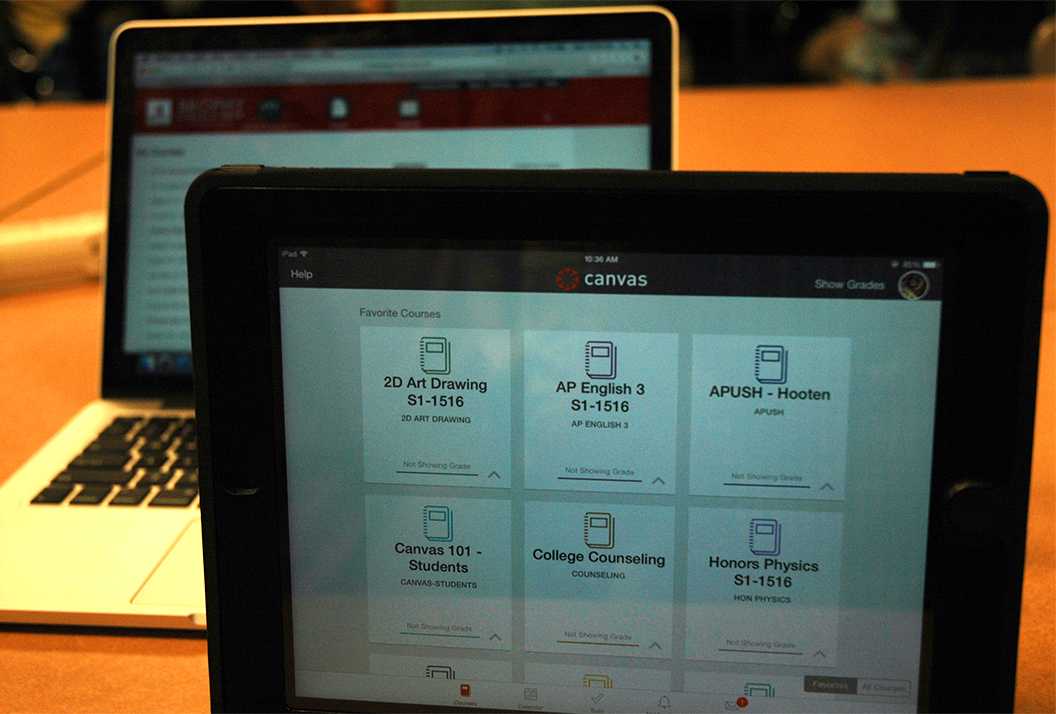Photo Illsutration by Cory Wyman ’16 – Canvas is the new class management program used by teachers and students alike, replacing the Blackboard of years past. This program has both a website for computers and an app for tablets.
By Anthony Cardellini ’17
THE ROUNDUP
A $5 million grant from the Virginia Piper Foundation headlined the administration’s decision to switch the Brophy course operation system to Canvas for this school year, said Assistant Principal of Technology Mr. Jim Bopp.
The grant, given to the Diocese of Phoenix, was awarded “to upgrade and improve the educational technology program of all six (Catholic high) schools,” Mr. Bopp said.
Together the six schools purchased licenses for Canvasm which replaced the previous online course management system, Blackboard.
However, Mr. Bopp said that the grant wasn’t the only reason for the switch.
“It’s not just a cost thing … we have confidence that it’s a comparable product, if not a better product,” Mr. Bopp said, comparing Canvas to Blackboard.
He explained that the Virginia Piper Foundation encouraged the six Catholic high schools to choose one operating system, with the intention of getting the best possible deal. The foundation will pay for Canvas for the next five years.
The schools received bids from Blackboard, Canvas, Moodle and Haiku, all in similar fields and offering similar services.
“Canvas was the hands-down favorite for every technology person that was there,” Mr. Bopp explained.
The switch has drawn questions and comparisons between Blackboard and Canvas.
Mr. Bopp said that while Blackboard was geared and designed with personal computers in mind, “Canvas had the leg up in terms of … mobile devices.”
He also cited the momentum gained by Canvas, as universities such as Yale and Stanford recently began to use its system.
Mr. Bopp said that he thinks the transition has gone “relatively smooth.”
English teacher Mr. Steve Smith ’96 said that the main difficulty in the switch was getting used to the features of Canvas.
“It’s tricky because the verbiage is different,” Mr. Smith said, who has been at Brophy since 2006. “The transitional stage is a little tough but I think it will be just fine in the end,” he said.
He said that he particularly liked using the turn in and test features.
“I use it for (the students) to turn in assignments because it has a plagiarism detector, and I use it for my tests because it gives them immediate feedback,” Mr. Smith said.
He also said that Canvas’ positives compared to Blackboard include an improved aesthetic.
Junior Connor Brachtl ’17 said that he thinks teachers learning to use Canvas will be key in helping the transition.
“Once the teachers learn how to use it and I get to use it a little bit more, I think I’ll learn to like it,” he said.
Brachtl also said that mobile platforms help Canvas reach where Blackboard couldn’t, but Blackboard still had the upper hand in some areas.
“Canvas is very useful because the app works a lot better. Blackboard was a lot more straightforward,” Brachtl said.
He also said that turning in assignments on Canvas was easier, but Blackboard was easier to personalize.
Senior Jeremy Lacsa ’16 said he agrees that Canvas is stronger with mobile devices.
“While Canvas is less powerful than Blackboard, it provides greater accessibility on mobile devices, which is most of the Brophy community,” Lacsa said.
He said that submission is easier on Canvas and that many of Blackboard’s features “go to waste because we have iPads.”
Mr. Bopp said he is unsure about what the future will hold for Brophy technology after the subscription to Canvas ends in five years.
“In terms of technology, five years is an eternity … To make that big of a change with anything so integral to campus is a big deal. It’s not something you do lightly.”
Lacsa said he is confident that the change was something positive.
“Even though it is our first year using Canvas, I’m sure that it was a step in the right direction,” he said.



















